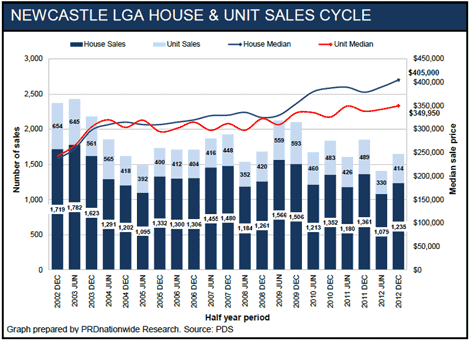Investor interest rising as sub-$300,000 Newcastle inner-city units offer 5% to 7% yield potential: PRDnationwide
The Newcastle residential real estate market strengthened in the last six months of 2012 with rising prices and rents attracting growing enquiries from out-of-town investors.
Interest has been particularly strong among investors for cheap inner-city units offering rental yields of between 5% and 7%.
Market momentum was also maintained by a stable presence of first-home buyer despite the withdrawal of the $7,000 grant at the end of September last year.
“Despite somewhat softer conditions in the Hunter Valley’s coal industry, record trade in the Newcastle port is driving the employment market in Newcastle, with infrastructure investment in the City positioning it as one of the most robust regions in NSW,” says PRDnationwide research analyst Oded Reuveni-Etzioni.
In December last year, the NSW announced a new master plan for the Newcastle CBD with the aime of revitalising the Newcastle City Centre.
“Marked by the termination of the railway at Wickham the plan prescribes a replacement of the existing railway line with a pedestrian-friendly corridor and is expected to stimulate investment in the CBD,” says Reuveni-Etzioni.
PRDnationwide records the Newcastle median house price up 9.3% $405,000 and the unit price up 6.4% just under $350,000 for the 2012 calendar year.
Both house and unit prices in Newcastle have been trending up since around June 2009 – though the progression has not been smooth, as the graph below prepared by PRDnationwide shows.
Click to enlarge
Final figures are not yet compiled for the six months to December 2012, but PRDnationwide expects they will mirror the December 2011 period when around 1,300 house and 489 unit sales were recorded.
Preliminary figures record 1,649 transactions for the year – 1,235 houses and 414 units sold.
PRDnationwide figures record that 40% of house sales and 68% of unit sales in the region where for properties in the inner city suburbs.
“Comparing the December 2012 unit price point with the corresponding period in 2011 revealed a 7% decline in units selling between $300,000 and $399,999 along with an increase in the size of price brackets between $400,000 and $800,000. The demand for luxury apartments priced $800,000 plus declined by two per cent from 2011,” says Reuveni-Etzioni.
Apartments priced below $300,000 made up 25% of unit sales over the year and yielding “attractive” rental returns of between 5% and 7% and proved attractive to investors.
Current investor listings include a two-bedroom Quest serviced apartment on Hunter Street seeking offers above $299,000 and marketed by Josh Mana of Raine & Horne – Newcastle. The apartment offers guaranteed income of $1,653 per month – a gross yield in excess of 6%.
Another inner city listing is a one-bedroom, sixth floor apartment on Watts Street being offered for $273,000 by Christian Booth of Robinson Property – the junction. The property is rented at $325 per week – a yield of 6.2%.
Reuveni-Etzioni says realistically-priced off-the-plan stock also experienced strong uptake from investors and first home buyers, with first time buyers taking advantage of the $15,000 first home buyers grant and stamp duty exemptions.
“There are currently approximately 250 units under development in the inner city, with a large portion of units sold off the plan. This level of development is considered adequate when the growth in demand for units is taken into consideration,” he says.
PRDnationwide records a Newcastle rental vacancy rate of 1.7% for January 2013.
Rental vacancy figures from the Real Estate Institute show a higher vacancy rate of 2.5% for February (2% for January), but still well below the balanced market figure of 3% - indicating a market that favours landlords over renters.
According to local council area figures, two-bedroom unit rents rose 7.3% over the year to $346 per week while three-bedroom house rents increased by 5.4% to $400 per week.
“Of particular interest was growth in rents for single bedroom apartments, with a median price increasing by 10.4% over 2012. Not surprisingly, the inner city represented 50% of single bedroom dwellings within the LGA,” says Oded Reuveni-Etzioni.
He says the strong performance of the Newcastle property market following the GFC “was initiated by first home buyers and upgraders, with investor activity increasing in 2012”.
“In the second half of the year first time buyers’ activity remained stable despite the cancellation of incentives for existing dwellings.
“A growing number of second-home buyers purchased units as a medium-term investment with an outlook to use it for their main residence in the long term.
“Investors were induced back into the market by rising rent prices and a decline in the cost of funding. Anecdotal evidence points to a growing number of out-of-town enquiries, with particular interest in inner city apartments,” says Reuveni-Etzioni.
In the detached housing market, the suburb of Merewether recorded the highest number of sales for the period (85 sales) followed by New Lambton (79 sales) with the $900,000 plus bracket almost doubling to represent 13% of the market in the second half of 2012.
Photo by Michael Coghlan, courtesy of Flickr.

